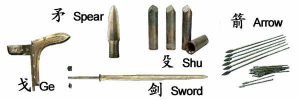On March 29, 1974, two farmers in the Shaanxi province of China inadvertently discovered thousands of life-sized terracotta figures. The warriors were created to accompany and protect their emperor in the afterlife, each one exhibiting different characteristics than the last. Thousands of bronze weapons were also dispersed throughout the warriors. By unearthing these artifacts left by the Qin dynasty, modern society is able to learn just how complex and intricate ancient Chinese society was.
Archaeologists rely on the record of Han dynasty historian Sima Qian for answers to the terracotta army. According to Sima Qian, over 700,000 slaves, indentured servants, and prisoners of war were forced to construct the figures. The power and authority that emperor Qin Shi Huang had over his dominion can immediately be inferred from this record. What doesn’t immediately come to mind, however, is how the society functioned during construction of the army. In order for 10 years and the labor of 700,000 people to be justified, there needed to be specialization among the populace.

An overview of the terracotta army. The army is buried in three pits with Pit No. 1 being the largest.
Slaves created the terracotta army, farmers grew the food, and metallurgists crafted the weapons. In other words, the society could not have existed if everyone was creating the army; each person had a specific niche that helped the society as a whole. Because of this, China during the Qin Dynasty can be referred to as one of the first examples of a state society.
To this day, archaeologists are pondering the techniques utilized to create the warriors in such a relatively short period of time. Some hypothesize that the entire army was created by a single artisan. Others say that an assembly line was used to pump out soldiers. A 2014 study conducted by researchers at University College London analyzed ears from 30 warriors to determine if they were different from each other. No two ears analyzed were alike inferring that the soldiers were different, however further testing needs to be done in order to support the theory.
Archaeologists were also puzzled as to how the bronze weapons found in the pits were manufactured. It was believed that an assembly line was used to create the immense amount of weapons, however, a recent study of 40,000 bronze arrowheads show that they were produced in independent workshops. By using X-ray fluorescence, the scientists discovered unique chemical signatures on the arrowheads. When these signatures were placed on a digital map, the scientists were able to determine that each arrowhead came from a single workshop, trumping the idea of an assembly line.
By studying artifacts, modern society can learn a great deal about life in the past. Modern technology is only enhancing the immense knowledge we can obtain from these artifacts. By simply observing the warriors, we are able to determine the existence of a state society and through X-ray fluorescence, we can debunk the theory of an assembly line. Future developments in archaeology can help us uncover more secrets from the past.
Sources:
Jarus, Owen. “Terracotta Warriors: An Army for the Afterlife.” LiveScience. 28 Nov. 2016. Web. 12 Feb. 2017.
http://www.livescience.com/25510-terracotta-warriors.html
Jennifer, Pinkowski. “Chinese terra cotta warriors had real, and very carefully made, weapons.” The Washington Post. 26 Nov. 2012. Web. 12 Feb. 2017.
Images:
http://www.rbarnhill.com/China1/Ch1_Terra_Cotta.php
http://www.chinatourguide.com/xian/terracotta_warriors_details.html
Further Readings:
http://www.history.com/news/greeks-may-have-influenced-chinas-terra-cotta-army


X-ray fluorescence has shown that there are multiple sources of metal used but are you aware the inscriptions on some of the bronze artifacts? Do these inscriptions allow for a further understanding of the different individuals or shops involved in the process of building this tomb?
Heres a cool article on bronze weapons at this site:
Li, Xiuzhen J., et al. Inscriptions, filing, grinding and polishing marks on the bronze weapons from the Qin Terracotta Army in China. Journal of Archaeological Science In Press, Corrected Proof,
Thanks for the comment! I did not know about the inscriptions on some of the bronze artifacts while researching this topic but the article you recommended has some interesting points that further prove that the weapons were produced in individual workshops rather than on an assembly line. The inscriptions on the halberds confirmed the name of a supervisor, officials, as well as craftsmen! This definitely proves specialization as there would not be a reason to denote the creator if the weapons were manufactured on an assembly line. These inscriptions also created accountability to the different manufacturers; an incentive to not mess up on production! The inscriptions show the sheer amount of specialized labor invested into the making of the Terracotta Army with no skills or resources being spared in its production.